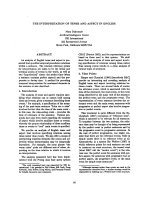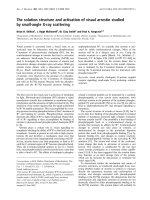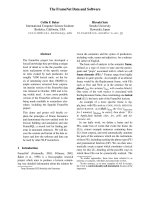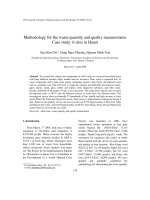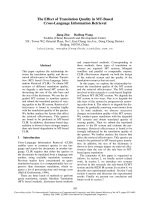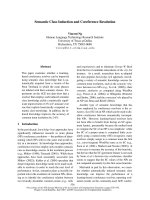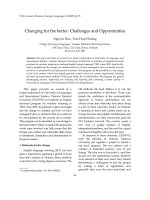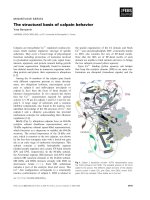Báo cáo " Methodology for the waste quantity and quality measurement " pptx
Bạn đang xem bản rút gọn của tài liệu. Xem và tải ngay bản đầy đủ của tài liệu tại đây (103.73 KB, 7 trang )
VNU Journal of Science, Natural Sciences and Technology 25 (2009) 145-151
145
Methodology for the waste quantity and quality measurement.
Case study: 6 sites in Hanoi
Ngo Kim Chi*, Dang Ngoc Phuong, Nguyen Minh Tam
Institute of Natural products Chemistry -Vietnamese Academy of Science and Technology,
18 Hoang Quoc Viet, Hanoi, Vietnam
Received 17 April 2009
Abstract. To research the volume and components of solid waste, we surveyed household waste
with three different incomes (high, middle and low incomes). Then waste is separated into 34
waste components and 9 main waste groups containing organic waste (easily decomposed waste
such as vegetable, root, fruit, left food to make the compost and difficultly decomposed waste),
paper, plastic, metal, glass, rubber and leather, cloth, dangerous substance, and other waste.
Besides, definition of all groups of waste is also discussed. The result shows that the ratio of easily
decomposed waste is 48.5% and the different sources of waste have the different ratios. The
investigative survey chose accidentally 35 households of low, middle and high incomes of each
wards, Phan Chu Trinh and Nguyen Du wards. Each survey is implemented continuously during 8
days. Based on the quantity survey, the survey results are 0.572 kg/person/day in Phan Chu Trinh
and Nguyen Du wards and 0.545 kg/person/day in Me Tri, Kim Giang, Dong Anh and Nghia Tan
wards where are far from the city center.
Keywords: solid waste, waste quantity and quality measurement.
1. Introduction
∗
From March, 1
st
2008, total area of Hanoi
expansion is 334.427ha, total population is
6,232,940 people. Hanoi economy has highly
developed; gross domestic product in 2008 is
12.5% [1]. Each day, Hanoi discharged more
than 3,300 tons of waste from households,
offices, restaurants, hotels, markets, food shops
[2]. The Project for the Implementation Support
for 3R Initiative in Hanoi City to Contribute to
the Development of a Sound Material-Cycle
_______
∗
Corresponding author. Tel.: 84-4-37912731.
E-mail:
Society was launched in 2006, have
implemented source separation at four pilot
wards: Nguyen Du (ND:0.45km
2
, 11,315
people), Phan Chu Trinh (PCT:0.41km
2
, 8,306
people), Thanh Cong and Lang Ha wards. The
estimation for expansion this model in whole
Hanoi started with the survey on waste quantity
and quality in four location: Kim Giang ward
(KG:0.22 km
2
, 10,118 people), Nghia Tan ward
(NT: 0.57km
2
, 22,790 people), Me Tri ward
(MT:7.06km
2
, 22,406 people), and Dong Anh
town (DA:4.57km
2
, 28,899 people). We have
applied and gradually completed the
methodology for determining the waste quantity
N.K. Chi et al. / VNU Journal of Science, Natural Sciences and Technology 25 (2009) 145-151
146
and quality under the controlling and guiding of
JICA experts. This method has considered an
effective one and easy to apply in surveying
household waste generation rate. This
methodology has applied in many countries in
the world: Japan, Indonesia, Singapore, and
Malaysia, India, Philippines, Uruguay, Vienna-
Austria, New Zealand, Hong Kong, Paris-
France, Caracas- Venezuela, Uruguay, Rio de
Janeiro – Brazil…[3]
2. Methodology
2.1. Preparation
1) Make the boundary, collect the economy
and social information, and unify the sample
size and household’s income level. 2) Make the
guiding document is clearer and more detail
then organizing training class for surveyors. 3)
Make the survey plan with residential group
and households, disseminating the survey
methodologies. 4) Distributing tools (waste
basket or nylon) fixed waste label. Residents
are guided to separate waste (inorganic waste
(InOW), organic waste (OW) and recycle waste
(Re) in the pilot wards) or recycle waste and
other waste at four locations which haven’t
participated in source separation. 5) Drawing
the survey map and marking the sampling
position
Make the survey table- survey form: Form
for surveying waste quantity is displayed in the
table 1
Table 1. Surveying the waste quantity in households.
Waste sample of each kind of waste type is
corresponding to income level. It is typically
sample to separate waste into 33 components, 9
main groups: I. Organic (1, left food, vegetable,
root, fruit, soybean. 2, animal bone, shell. 3,
Grass, flower, leaf. 4, coconut skin, wood,
bagasse); II Paper (5, paper, magazine. 6,
cigarette box, carton. 7, milk box. 8, book,
notebook. 9, photocopy paper. 10, used paper.
11, other papers); III. Plastic (12, PET. 13,
other bottles. 14, nylon. 15, tray, plastic cup.
16, polystyrene foam. 17, household plastic. 18,
other plastics); IV, metal (19, metal can. 20,
Steel, aluminum scraps. 21, Aluminum can. 22,
other metals); V. Glass (23, glass bottles. 24,
glass, pottery); VI. Leather, rubber (25, rubber.
26, leather); VII. Cloth (27, used textiles); VIII.
Dangerous substance (28. Battery. 29, lamps);
IX. Others (30. Briquette coal, 31, diapers, 32,
old electrics
2.2. Sampling, number of samples
The sample number of Phan Chu Trinh
wards with [35 high income households+ 35
middle income households+ 35 low income
households)* 3 samples (OW, InOW, Re)]*8
days= 2520 samples, the same with Nguyen Du
wards. Number of business waste samples
contains 10 samples of food waste, 1 sample of
market waste, 20 samples of office waste, and 5
samples of flower waste. In Nghia Tan, Me Tri,
Dong Anh and Kim Giang, number of
household samples are 4 sites*(20 high income
households + 20 middle income households+
20 low income households)*8 days= 1920
samples. The number of business sample are 4
sites * 20 business (food, restaurant, market and
office waste)* 8 days = 640 samples. It is
surveyed with 32 samples of household waste
component, 80 samples of business waste and
48 samples of road waste in four days of four
other sites.
N.K. Chi et al. / VNU Journal of Science, Natural Sciences and Technology 25 (2009) 145-151
147
2.3. Sampling method
Households of Phan Chu Trinh and Nguyen
Du wards separated waste into three kinds,
households of Kim Giang, Dong Anh, Nghia
Tan and Me Tri separated waste into two kinds
(recycle waste and dumped waste), stored waste
at households until the end of day, surveyor
came to weigh each kind of waste and collect it
daily. (Purchased recycle waste if they
required). Collecting waste sample of
households, business, road waste and waste at
collection points according to the sampling
map.
2.4. Measuring the waste quantity and
separating waste
Each kind of waste (Re, or InOW or OW)
of each income level was weighed at household
then filled in information in the form 1,
collected all waste at one point, randomly
sampled (20kg) then separated into 33
components (balance sizes are 1kg, 5kg, 10kg
and 20kg). Separating procedure contains:
1) Putting waste in the big dry nylon bags.
2) Mixing and reducing the sample volume
according to the standard method – the out put
of this progress is 20kg of waste (Mixing, piling
up to the pyramid form, dividing into 4 equal
parts, taking two opposite parts) and 3)
Separating 33 components like the above
category.
2.5. Measuring the waste volume after separation
1) Use the volume barrel 20l -60l to
measure and weigh the quantity of each
component. 2) Measure the waste density. 3)
Measuring the moisture from the typical
samples which were measured density. [4] (To
dry until the unchangeable quantity, in about 2
days at 120
0
C)
2.6. Inputting date, calculating date and
analyzing results
Inputting the date of 8 days, calculating date
from the second day in excel: i) The average
generation rate per person per day, ii) The trend
of waste generation in a week iii) Waste
component.
3. Survey result and discussion
The survey results are displayed in the table
2 and 3
Table 2. The survey result of waste quantity in Phan
Chu Trinh and Nguyen Du wards
The average
specification
PCT ND Average
kg/head/day 0.587 0.557 0.572
kg/week/HH 16.11 13.92 15.02
Table 3. The survey result of waste quantity in
Kim Giang ward, Nghia Tan ward, Me Tri commune
and Dong Anh town
Site KG NT MT DA Ave
kg/head/day 0.53 0.59 0.57 0.48 0.55
kg/week/HH 13.25 15.68 18.7 12.44 15.0
Waste generation rate. Phan Chu Trinh and
Nguyen Du has the average number of people
per household is 3.572 people. The average
generation quantity of household waste: 0.572
kg/person/day including recycle waste and
equivalent to 2.146 kg/household/day [5]. The
survey time in July, from 23 to 31, 2008, and
survey result in summer is higher than in the
winter 1.98 kg/household/day or 0.475
kg/person/day [5]. The quantity results are
different between two wards in urban area
(PCT, ND) and four locations in suburban area
(KG, NT, MT, DA), with waste generation rate
of 0.545 kg/person/day or 2.146
kg/household/day (table 3), and 3.938 people
per household.
N.K. Chi et al. / VNU Journal of Science, Natural Sciences and Technology 25 (2009) 145-151
148
Relation between waste quantity and
income level. The analyzing result shows that
there is a different of waste quantity among
high income, middle income and low income
households. However, it is not considerable
(example, the distance between high income
and middle income is 0.06 kg/person/day, and it
is 0.08 kg/person/day between middle income
and low income, PCT, ND) , table 2.
The waste generation trend in a week. The
result of all 6 survey wards shows that waste
quantity (not included the recycle waste
quantity) increases at the weekends
Fig. 1. Waste generation trend in a week, kg/head,
Phan Chu Trinh and Nguyen Du, 23-30/7/2008.
Fig. 2. Waste generation trend in a week, kg/person,
Kim Giang, Nghia Tan, Me Tri and Dong Anh,
24/9 -1/10-2008.
a) Result of easily decomposed household
waste
The analyzing result of household waste
shows that the easily decomposed waste is
47%, difficultly decomposed waste is 6%,
paper is 9%, plastic is 10%, metal is 2%, glass
is 5%, leather and rubber is 1%, other waste is
18% (The average result of 6 surveyed wards).
In Phan Chu Trinh and Nguyen Du, the easily
decomposed waste ratio is 48.5%, this ratio is
44.6% and the total organic ratio is 49.7% in
Kim Giang, Me Tri, Nghia Tan and Dong Anh).
The organic component of market, food
shop, restaurant, and hotel: The total organic
waste ratios of food shop and market waste are
64.65% and 63.25% respectively. Organic
waste ratio of food shop and market is higher
than the household waste from 10.69% to
12.10%. Organic waste ratio of office waste
and road waste is lower than other with 45.65%
and 47.95% respectively.
Fig. 3. Organic waste ratio in different waste type, %.
Fig. 4. Metal ratio in each different waste type, %.
N.K. Chi et al. / VNU Journal of Science, Natural Sciences and Technology 25 (2009) 145-151
149
b) Paper ratio is various with different waste
Office waste is the highest ratio, survey
result of Kim Giang, Me Tri, Dong Anh and
Nghia Tan displayed the 24% of office waste
while the paper ratio in the household waste of
these four wards is only 9.4%.
c) The recycle plastic
The recycle plastic in household waste of
all surveyed wards had the average ratio of
4.66%; this rate was 3.6% in Phan Chu Trinh
and Nguyen Du and 5.25% in Kim Giang,
Nghia Tan, Me Tri and Dong Anh
d) Metal
The average surveyed result of all locations
is displayed in the figure 4.
e) Hazardous substance in waste
Dangerous substance has the worrying
sign. Households have the higher ratio of
dangerous waste than office waste, market
waste…. Most of the surveyed waste source
had got the dangerous substance.
Table 4. Result on dangerous substance of 6
surveyed sites
Source Ratio
Household waste 0.037%
Market waste 0.002%
Flower waste 0.000%
Market waste 0.003%
Food waste 0.006%
Restaurant waste 0.007%
Office waste 0.006%
Table 5 Average waste density in 6
surveyed sites
Source waste
PCT,
ND
(kg/m
3
)
KG, MT,
DA, NT
(kg/m
3
)
Ave
(kg/m
3
)
Food shop 395 336 366
Flower shop 236 228 232
Market 258 312 285
Road 265 257 261
Office 167 192 180
Restaurant 267 267
f) Density. Density result is displayed in the
table 5
g) Moisture depended on the weather; the
average results in the sunny day are displayed
in the table 6.
Table 6. The average results in the sunny day, Phan
Chu Trinh and Nguyen Du wards
Moisture, % Source
waste
HH Food shop
Market
Restaur
ant
Organic
waste
73.23 75.8 62.33 68.77
Paper 38.68 38.67 34.67 37.33
Plastic 10.33 10.23 11.47 10.63
Metal 3.37 3.56 4.03 4
Glass 4.67 4.61 1.8 3.23
Rubber 9.35 9.52 9.93 9.73
Cloth 8.8 8.33 11.27 9.7
Wood 43 42.7 40.83 41.67
Ceramic 3.95 3.87 1.87 4
Other
plastic
10.28 10.5 8.3 10.33
4. Conclusion and proposals
With the above methodology, the average
generation rate of surveyed locations is 0.559
kg/person/day. The waste component are
diversified, easily decomposed organic counted
47%, recycle plastic counted 4.66%, total
plastic is 10%. The survey shows that each
waste source has the different result, flower
waste has the highest ratio of organic waste,
and the food waste is in the second rank. Office
waste and household waste has the high
percentage of metal with 2.74% and 2.31%
respectively
Appling the above methodology has been
realizable in Vietnam, with the trust result.
Through the survey result, it can determine the
waste that needs to be dumped; the recycle
waste should be reused and organic waste for
N.K. Chi et al. / VNU Journal of Science, Natural Sciences and Technology 25 (2009) 145-151
150
composting. If the pilot program is applied in
the big size then the solution for Hanoi solid
waste management will have the optimum
answer.
Suggestions: Technical size: 1) It needs to
carefully prepare and train surveyors following
the above procedures 2) To ensure the surveyed
quantity is correct, it should distribute waste
store tools for household each day after
weighting waste. 3) To reduce the magnitude of
errors arising from moisture change and from
decomposition, analysis of the samples should
start within two to three hours after collection.
4) Sample size after mixing required larger
enough. On the other hand, if the sample size is
too small, the possibility of obtaining a
representative sample is lessened. The
minimum sample size after mixing should be on
the order of 20kg. 5) Encouraging and
reminding citizens to cooperate and weight
waste every day. It should be improved source
separation in the two pilot wards Phan Chu
Trinh and Nguyen Du and its expansion in
other areas of Hanoi: (i)3R program is suitable
and need to be communicated for citizens (ii)
source separation should be widen more. It
needs to strongly supervise and punish citizen
in the pilot wards if they freely discharge waste
or do not follow the source separation program.
It is recognized that hazardous waste is
count for 0.037% in the household waste so that
it should be more concerned in municipal solid
waste of Hanoi to find suitable separation
model for households and business entireties.
Separating this hazardous waste from the
general stream can create the great way to
reduce dangerous substances for recycling and
dumping site management.
Acknowledgement: These surveys were
done by the financial support of 3R-HN project
in Hanoi with the enthusiastic guideline of
JICA expert Mr. Hirata and the supervisor of
Ms Nguyen Huong Giang. The survey had
received good cooperation from Environmental
Enterprise No 2, Environmental Enterprise No
3, Sanitation Cooperative Thanh Cong, Tay Do
Company, Dong Anh environmental Company.
Reference
[1] Hanoi yearbook, 2008
[2] Report of Hanoi urban environmental company,
2008
[3] Solid waste management, UNEP,
/>d_Waste_Management/index.asp
[4] Survey result on waste quantity and quality in
Kim Giang, Me Tri, Nghia Tan and Dong Anh,
24/9/08 to 1/10/08, Survey report-3R_HN
project.
[5] Survey result on waste quantity and quality in
Phan Chu Trinh and Nguyen Du wards, 23-
30/7/08_Survey report- 3R_HN project.
[6] Survey result on waste quantity and quality in
Phan Chu Trinh, Nguyen Du from 3/2/007 to
9/02/007, Survey report - 3R_HN project.
N.K. Chi et al. / VNU Journal of Science, Natural Sciences and Technology 25 (2009) 145-151
151
Phương pháp nghiên cứu khối lượng và thành phần rác thải,
nghiên cứu tại 6 phường và thị trấn của Hà Nội
Ngô Kim Chi, Đặng Ngọc Phượng, Nguyễn Minh Tâm
Viện Hóa học các hợp chất thiên nhiên, Viện Khoa học và Công nghệ Việt Nam,
18 Hoàng Quốc Việt, Hà Nội, Việt Nam
Phương pháp nghiên cứu lượng phát thải và thành phần rác thải trên cơ sở mức thu nhập của hộ
đình và phân chia chi tiết đến trên 34 loại rác thải với 9 nhóm chất thải chính là chất hữu cơ (gồm hữu
cơ dễ phân hủy như rau, củ quả, thức ăn thừa để làm phân compost và chất hữu cơ khó phân hủy),
giấy, nhựa, kim loại, thủy tinh, da và cao su, vải, chất nguy hại và các chất khác. Bên cạnh đó đưa ra
các định nghĩa và các chú thích chi tiết về các thành phần rác của các nhóm chính này. Kết quả cho
thấy, tỉ lệ rác hữu cơ dễ phân hủy là 48.5% và thành phần của các loại rác khác nhau có tỉ lệ khác
nhau. Kết quả điều tra tại 35 hộ lựa chọn ngẫu nhiên thu nhập cao, 35 hộ gia đình thu nhập trung bình
và 35 hộ thu nhập thấp. Điều tra liên tục trong 8 ngày. Trên cơ sở thu gom mẫu đo định lượng lượng
rác tại các hộ, kết quả cho thấy lượng rác của một người thải ra trong một ngày của khu vực nội thành
như Nguyễn Du và Phan Chu Trinh là 0.572 kg/người/ngày tại các phường xa trung tâm thành phố
như Mễ Trì, Kim Giang, Đông Anh và Nghĩa Tân có trung bình xả thải là 0.545 kg/người/ngày.
